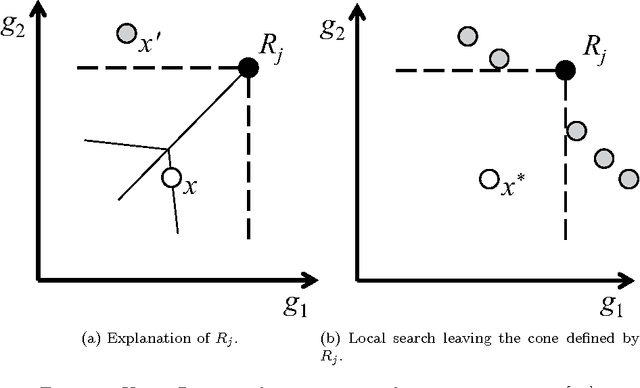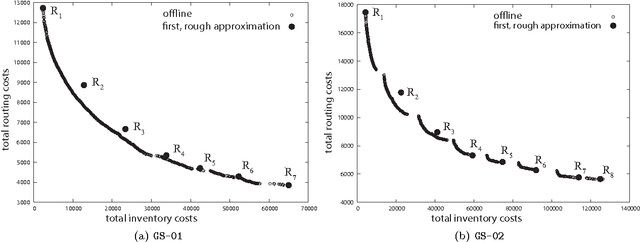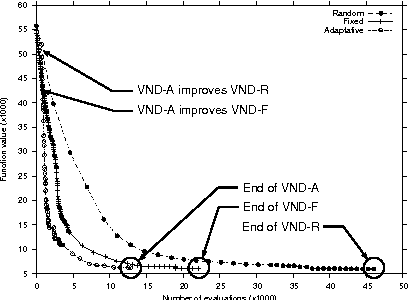Marc Sevaux
Hybrid Node-Destroyer Model with Large Neighborhood Search for Solving the Capacitated Vehicle Routing Problem
Aug 12, 2025Abstract:In this research, we propose an iterative learning hybrid optimization solver developed to strengthen the performance of metaheuristic algorithms in solving the Capacitated Vehicle Routing Problem (CVRP). The iterative hybrid mechanism integrates the proposed Node-Destroyer Model, a machine learning hybrid model that utilized Graph Neural Networks (GNNs) such identifies and selects customer nodes to guide the Large Neighborhood Search (LNS) operator within the metaheuristic optimization frameworks. This model leverages the structural properties of the problem and solution that can be represented as a graph, to guide strategic selections concerning node removal. The proposed approach reduces operational complexity and scales down the search space involved in the optimization process. The hybrid approach is applied specifically to the CVRP and does not require retraining across problem instances of different sizes. The proposed hybrid mechanism is able to improve the performance of baseline metaheuristic algorithms. Our approach not only enhances the solution quality for standard CVRP benchmarks but also proves scalability on very large-scale instances with up to 30,000 customer nodes. Experimental evaluations on benchmark datasets show that the proposed hybrid mechanism is capable of improving different baseline algorithms, achieving better quality of solutions under similar settings.
Study of Robust Features in Formulating Guidance for Heuristic Algorithms for Solving the Vehicle Routing Problem
Aug 08, 2025Abstract:The Vehicle Routing Problem (VRP) is a complex optimization problem with numerous real-world applications, mostly solved using metaheuristic algorithms due to its $\mathcal{NP}$-Hard nature. Traditionally, these metaheuristics rely on human-crafted designs developed through empirical studies. However, recent research shows that machine learning methods can be used the structural characteristics of solutions in combinatorial optimization, thereby aiding in designing more efficient algorithms, particularly for solving VRP. Building on this advancement, this study extends the previous research by conducting a sensitivity analysis using multiple classifier models that are capable of predicting the quality of VRP solutions. Hence, by leveraging explainable AI, this research is able to extend the understanding of how these models make decisions. Finally, our findings indicate that while feature importance varies, certain features consistently emerge as strong predictors. Furthermore, we propose a unified framework able of ranking feature impact across different scenarios to illustrate this finding. These insights highlight the potential of feature importance analysis as a foundation for developing a guidance mechanism of metaheuristic algorithms for solving the VRP.
Metaheuristic Enhanced with Feature-Based Guidance and Diversity Management for Solving the Capacitated Vehicle Routing Problem
Jul 30, 2024Abstract:We propose a metaheuristic algorithm enhanced with feature-based guidance that is designed to solve the Capacitated Vehicle Routing Problem (CVRP). To formulate the proposed guidance, we developed and explained a supervised Machine Learning (ML) model, that is used to formulate the guidance and control the diversity of the solution during the optimization process. We propose a metaheuristic algorithm combining neighborhood search and a novel mechanism of hybrid split and path relinking to implement the proposed guidance. The proposed guidance has proven to give a statistically significant improvement to the proposed metaheuristic algorithm when solving CVRP. Moreover, the proposed guided metaheuristic is also capable of producing competitive solutions among state-of-the-art metaheuristic algorithms.
A History of Metaheuristics
Apr 04, 2017

Abstract:This chapter describes the history of metaheuristics in five distinct periods, starting long before the first use of the term and ending a long time in the future.
Interactive Reference Point-Based Guided Local Search for the Bi-objective Inventory Routing Problem
May 22, 2014



Abstract:Eliciting preferences of a decision maker is a key factor to successfully combine search and decision making in an interactive method. Therefore, the progressively integration and simulation of the decision maker is a main concern in an application. We contribute in this direction by proposing an interactive method based on a reference point-based guided local search to the bi-objective Inventory Routing Problem. A local search metaheuristic, working on the delivery intervals, and the Clarke & Wright savings heuristic is employed for the subsequently obtained Vehicle Routing Problem. To elicit preferences, the decision maker selects a reference point to guide the search in interesting subregions. Additionally, the reference point is used as a reservation point to discard solutions outside the cone, introduced as a convergence criterion. Computational results of the reference point-based guided local search are reported and analyzed on benchmark data in order to show the applicability of the approach.
Solution Representations and Local Search for the bi-objective Inventory Routing Problem
Apr 18, 2012Abstract:The solution of the biobjective IRP is rather challenging, even for metaheuristics. We are still lacking a profound understanding of appropriate solution representations and effective neighborhood structures. Clearly, both the delivery volumes and the routing aspects of the alternatives need to be reflected in an encoding, and must be modified when searching by means of local search. Our work contributes to the better understanding of such solution representations. On the basis of an experimental investigation, the advantages and drawbacks of two encodings are studied and compared.
Neigborhood Selection in Variable Neighborhood Search
Sep 15, 2011
Abstract:Variable neighborhood search (VNS) is a metaheuristic for solving optimization problems based on a simple principle: systematic changes of neighborhoods within the search, both in the descent to local minima and in the escape from the valleys which contain them. Designing these neighborhoods and applying them in a meaningful fashion is not an easy task. Moreover, an appropriate order in which they are applied must be determined. In this paper we attempt to investigate this issue. Assume that we are given an optimization problem that is intended to be solved by applying the VNS scheme, how many and which types of neighborhoods should be investigated and what could be appropriate selection criteria to apply these neighborhoods. More specifically, does it pay to "look ahead" (see, e.g., in the context of VNS and GRASP) when attempting to switch from one neighborhood to another?
* ISBN 978-88-900984-3-7
On the use of reference points for the biobjective Inventory Routing Problem
Sep 14, 2011



Abstract:The article presents a study on the biobjective inventory routing problem. Contrary to most previous research, the problem is treated as a true multi-objective optimization problem, with the goal of identifying Pareto-optimal solutions. Due to the hardness of the problem at hand, a reference point based optimization approach is presented and implemented into an optimization and decision support system, which allows for the computation of a true subset of the optimal outcomes. Experimental investigation involving local search metaheuristics are conducted on benchmark data, and numerical results are reported and analyzed.
Practical inventory routing: A problem definition and an optimization method
Feb 28, 2011


Abstract:The global objective of this work is to provide practical optimization methods to companies involved in inventory routing problems, taking into account this new type of data. Also, companies are sometimes not able to deal with changing plans every period and would like to adopt regular structures for serving customers.
 Add to Chrome
Add to Chrome Add to Firefox
Add to Firefox Add to Edge
Add to Edge